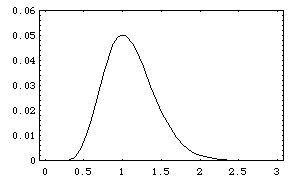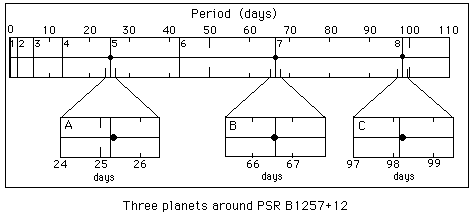
Theoretical prediction of the semi-major axes of the orbits of extra-solar planets.
L. Nottale
(from Astron. Astrophys. 315, L9 (1996) and 322, 1018 (1997))
The theory of scale relativity allows one to set in a renewed way the problem of the formation and evolution of planetary systems.
As in the standard model of formation, the planets are assumed to be formed by accretion of planetesimals. However, the initial distribution of probability density of these planetesimals can no longer be any distribution in our theory, but is instead given by the solutions of a generalized Schrödinger equation.
Such a Schrödinger-like equation is obtained from a generalization of Newton's equation of dynamics in which fluctuation and irreversibility terms aimed at describing the assumed inner fractal structures of space-time have been included. These structures show up, in this domain, only at (relatively) long time scales.
The solutions of our generalized equation of dynamics in the case of a Kepler potential (two-body problem) define "orbitals" similar to that of the hydrogen atom.
Example of probability density distribution (n = 5):

The planetesimals are expected to fill such orbitals, then to form a planet by accretion. The final position of the planet is given to lowest order by the probability peak of the orbital. The positions of these peaks can take only quantized values given by :
an = GM n2 / w2.
In this formula (which corresponds to circular orbits), M is the mass of the central star and w is a constant having the dimension of a velocity. The theory is expected to apply to two-body gravitational systems whatever the scale, i.e., not only to star-planet configurations, but also double stars and binary galaxies (Tifft effect). From several galactic and extragalactic samples, this constant is found to be a multiple or submultiple (depending of the particular system considered) of the universal constant:
w0 = 144.7 ± 0.6 km/s .
It is easy to verify that our own inner Solar System is structured according to this law and that the recently discovered extra-solar planets also agree remarkably well with it. We stress the fact that this is not a Titius-Bode-like law (it is not scale-invariant), and mainly that this law is totally constrained: there is no fit in the figure below.
Comparison between the observed positions of planets around solar-type stars and the predicted distances of probability density peaks:

For extra-solar planets (see catalog), the ratios a/M are computed from the periods (derived from the observed reflex motion of the star) using Kepler's third law. Their uncertainty is dominated by the uncertainty on the star mass, (10% in most cases), which we have derived from its spectral type when no more precise determination exists. The white bands correspond to the high probability zones, i.e. to effective n's in the interval [n-1/4, n+1/4]. The grey bands are for low probability zones, i.e. effective n's in the interval [n+1/4, n+3/4]. The effective n's are given, in terms of the observed period T and of the estimated star mass M, by (T / 3.25 M)1/3. The figure shows their clustering around integer values.
The probability to obtain such a configuration by chance is P = 214 = 6 105.
One of the most remarkable predictions of the theory, which has been performed "in a blind way" four years before the first discovery of extra-solar planets, is that the peak of the fundamental orbital n = 1 lies around 0.05 U.A. for 1 solar mass stars. The discovery of 51 Peg B, then of two additional planets at such a distance from their star is a remarkable confirmation of that prediction.
Comparison between the observed and predicted periods of planets around the pulsar PSR B1257+12

In the case of the planetary system around the pulsar PSR B1257+12 (Wolszczan, 1994, Science 264, 538), the agreement between theory and observations is so good that higher order terms can be tested. The mean distance of the probability density distribution is quantized as n2 +n/2. Using Kepler's third law, we find that we can predict the periods of two of the planets from the third with an uncertainty of about 1 hour (see figure). The probability of obtaining such a result by chance is only P < 104. If other planets exist in this system, their expected periods (in the case when they are smaller than 200 days) are as follows:
| 0.322 | 1.957 | 5.956 | 13.37 | 25.24 | 42.63 | 66.58 | 98.15 | 138.4 | 188.3 |
| 25.34 | 66.54 | 98.22 |
The table gives the predicted periods (in days) for n = 1 to 10, and compares them to the three observed periods (Wolszczan A., 1994). Remark that the fluctuations of these orbital periods due to mutual gravitational perturbations have been observed and are of the order of 0.02 days.
References:
L. Nottale, Fractal Space-Time and Microphysics (World Scientific, 1993), Chapter 7.2: "Beyond chaos"
L. Nottale, in "Cellular Automata, Prospects in Astrophysical Applications", Eds. J.M. Perdang & A. Lejeune, Proceedings of Han-sur-Lesse Colloquium, Oct. 1992 (World Scientific, 1993), p.268: "Emergence of structures from chaos"
L. Nottale, 1996, Astron. Astrophys. Lett. 315, L9 : "Scale relativity and quantization of extra-solar planetary systems"
L. Nottale, G. Schumacher & J. Gay, 1997, Astron. Astrophys. 322, 1018: "Scale relativity and quantization of the Solar System"
L. Nottale, 1997, Chaos, Solitons & Fractals, 8, in press : "Scale relativity and quantization of the planetary system around the pulsar PSR B1257+12"
Updated 12 May 1997